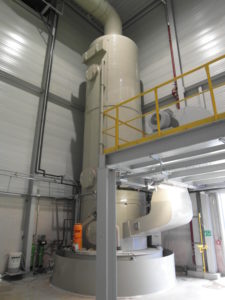
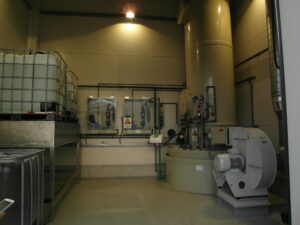
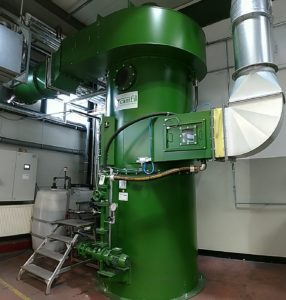
Wet scrubber for the separation of gaseous contents
Absorption scrubbers are used to reduce gaseous contaminants. Absorbable pollutants are mostly inorganic compounds such as: Ammonia NH3, hydrogen sulfide H2S, hydrogen chloride HCl, sulfur dioxide SO2, amines, etc.
Typical applications:
- Exhaust air from galvanic plants – Pollutants: HCl, NH3, …
- Exhaust air from core shooters – pollutants: amines, SO3
- Exhaust air from semiconductor production – pollutants: HCl, NH3, SiH4
- Exhaust air from sewage treatment plants – pollutants: H2S, NH3
- The exhaust air streams from the production processes are cleaned from the pollutant gases in absorption scrubbers based on the solubility of the pollutant gases in scrubbing liquids.
The scrubbing liquids used are adapted to the particular pollutant to achieve optimum efficiency. The absorption scrubbers are designed as spray scrubbers (nozzle scrubbers) or packed scrubbers. The design can basically be horizontal or vertical.
PlasmaAir AG offers vertical packed scrubbers as standard. Each scrubber or exhaust air system is designed according to the process technology.
Absorptionswäscher sind oftmals Bestandteil komplexer Anlagen, sie müssen die gesetzlichen Bestimmungen erfüllen und gleichzeitig optimale Wirtschaftlichkeit und zuverlässigen Betrieb garantieren. Die Wirtschaftlichkeit wird auf Grund der weiter steigenden Kosten für die Entsorgung von Reststoffen entscheidend verbessert, wenn es gelingt, die Absorptionsanlagen so in die technologischen Verfahren zu integrieren, dass entweder ein Kreislaufbetrieb gewährleistet werden kann, oder dass die entstehenden Reststoffe in einer kostengünstig zu entsorgenden Form anfallen.
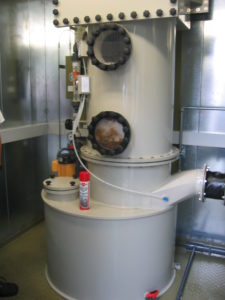
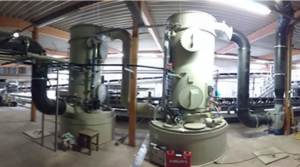
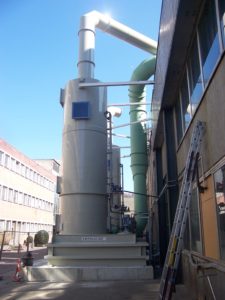
Absorption scrubber type FK
Countercurrent absorption scrubbers create favourable equipment conditions for physical and chemical adsorption, in which high pollutant gas separation efficiencies are achieved in compact plants.
The advantages are:
- Large gas/liquid boundary layers, which are constantly renewed.
- Low apparative pressure losses due to the use of high-performance packings
- Availability of absorption scrubbers and internals in corrosion-resistant materials (including plastics, stainless steels, ceramic materials)
These scrubbers are preferably constructed as packed column scrubbers. In most cases, the pollutants in the water react acidically or alkaline. Therefore, the columns are usually made of plastic. PP or PE are suitable for this purpose. Due to these materials, the temperature range is limited to a maximum of 60°C. For higher exhaust air temperatures, a cooler or a quench must be connected upstream.
The pressure drop of the scrubber is mainly determined by the diameter and the sprinkling density. The separation efficiency is mainly determined by the height of the packed bed. While the diameter of the standard scrubber is determined by the air flow rate, the packing height must be calculated and adjusted for each application.
Zubehör/Ausstattung:
Füllkörperkolonne
Integrierter Waschflüssigkeitsbehälter
Eingebauter Demister zur Abscheidung von Tropfen
Erfassungshauben
Rohgasleitung zur Emissionsquelle
Ventilator, Schalldämpfer
Reingasleitung, Kamin
Dosierstationen für Chemikalien
MSR–Einrichtung zum automatischen Betrieb der Anlage
pH-Wert Messung
Durchflussmessung Umlaufwasser
Automatikventil zur Absalzung
Niveausonde inkl. Schaltkontakte
Automatikventil zur Frischwasserzugabe
Druckanzeige in Umlaufwasser
Überfüllsicherung
Sicherheitswanne mit Leckagesonde
Waschflüssigkeitsbeheizung bei Außenaufstellung
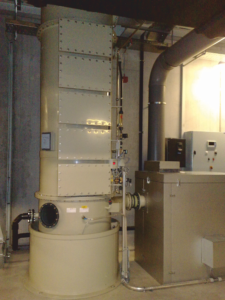
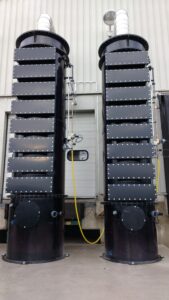
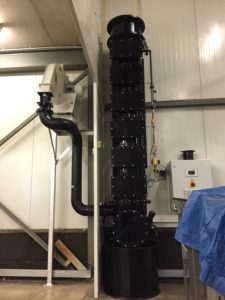
Ethanol- & Isopropanol separation from exhaust air
In the case of cleaning systems or alcohol coatings and the use of isopropanol or ethanol, clean gas values above the legally prescribed limit of 50 mg/m3 must be reduced.
With our newly developed scrubber type DB, the limit values are complied with at lowest water consumption.
This new type of scrubber – the sieve tray scrubber – was developed and qualified especially for cleaning exhaust air loaded with alcohols.
Advantages of the sieve tray scrubber:
- no water circulation pump
- low investment costs
- low operating costs
- the waste water can be discharged directly into the sewage treatment plant (discharge limit 2 g/l)
- low maintenance costs
In addition to the low-cost construction, another advantage of this system concept is that the lead time and the follow-up time are very short. This means that the plants can be switched on or off as required.
In principle, it is possible to build the scrubbers from plastic, stainless steel as well as steel, thus taking into account corrosion aspects.
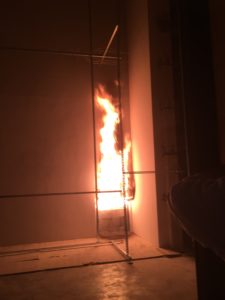

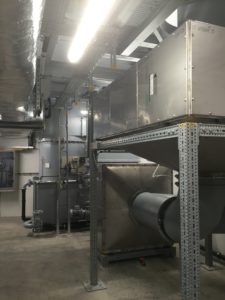
Extraction from fire rooms and battery test stands –
combination process for the separation of dust and gas
The major advantages of a wet separator are its unsurpassed robustness and maintainability, as well as process-related advantages when it comes to separating gaseous particles or conditioning the cleaned air in certain processes.
Dust Collector
Venturi dust collectors and vortex scrubbers provide highly efficient, low-maintenance separation of dusts when processing fire- and explosion-hazardous materials.
The operating principle of wet separation
The particles dispersed in the gas stream are brought into contact with a scrubbing liquid in order to bind them therein. For this purpose, the largest possible phase interface must be created between the gas (air) and the liquid. A flow deflection of the gas takes place. Due to the mass inertia, the particles move towards the liquid surface and are bound or deposited there.
The advantages of the wet separator for dust:
- operation without filter elements
- safest solution for processing fire and explosive materials
- suitable for many applications
- high separation efficiency with highest operational safety
- low maintenance
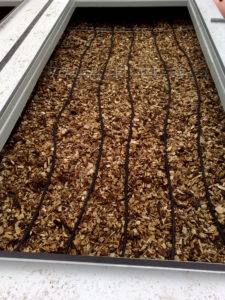
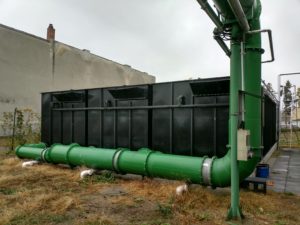
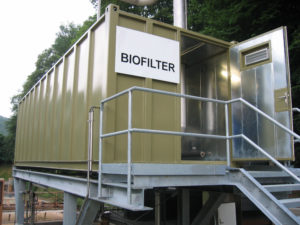
Biological exhaust air purification
A biofilter is an exhaust air purification process for the treatment of water-soluble, microbiologically degradable airborne substances. In contrast to other processes, biological oxidation – i.e. elimination of the pollutants – does not result in any disposal costs for the pollutants concentrated in the filter.
Biofilters have proven to be an economical and reliable system for the elimination of organic hydrocarbons and odour-intensive pollutants, especially for large exhaust air volume flows. Large systems are primarily designed as surface filters or as stackable individual modules. In contrast to the lower investment costs when using a panel filter, there is a higher operational reliability as well as a lower footprint requirement with the container filter, since the bed is protected from disturbing environmental influences and the relatively small surface unit can be influenced with regard to the homogeneous flow. A much greater advantage lies in the simple expandability of corresponding systems, through the possibility of stacking the individual modules. Depending on the area of application, the exhaust air must be conditioned before entering the biofilter. For this purpose, special scrubbers are used to cover areas such as grease separation, dust separation, temperature control and humidification.
Pilot tests can be carried out with our mobile test plant prior to plant design. The aim of these tests is the optimal adaptation to customer-specific requirements.

